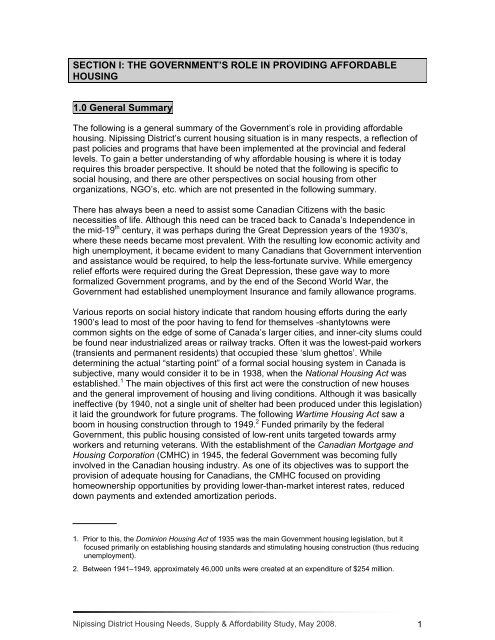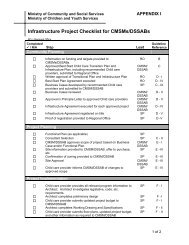Nipissing District Housing Needs, Supply & Affordability ... - dnssab
Nipissing District Housing Needs, Supply & Affordability ... - dnssab
Nipissing District Housing Needs, Supply & Affordability ... - dnssab
You also want an ePaper? Increase the reach of your titles
YUMPU automatically turns print PDFs into web optimized ePapers that Google loves.
SECTION I: THE GOVERNMENT’S ROLE IN PROVIDING AFFORDABLE<br />
HOUSING<br />
1.0 General Summary<br />
The following is a general summary of the Government’s role in providing affordable<br />
housing. <strong>Nipissing</strong> <strong>District</strong>’s current housing situation is in many respects, a reflection of<br />
past policies and programs that have been implemented at the provincial and federal<br />
levels. To gain a better understanding of why affordable housing is where it is today<br />
requires this broader perspective. It should be noted that the following is specific to<br />
social housing, and there are other perspectives on social housing from other<br />
organizations, NGO’s, etc. which are not presented in the following summary.<br />
There has always been a need to assist some Canadian Citizens with the basic<br />
necessities of life. Although this need can be traced back to Canada’s Independence in<br />
the mid-19 th century, it was perhaps during the Great Depression years of the 1930’s,<br />
where these needs became most prevalent. With the resulting low economic activity and<br />
high unemployment, it became evident to many Canadians that Government intervention<br />
and assistance would be required, to help the less-fortunate survive. While emergency<br />
relief efforts were required during the Great Depression, these gave way to more<br />
formalized Government programs, and by the end of the Second World War, the<br />
Government had established unemployment Insurance and family allowance programs.<br />
Various reports on social history indicate that random housing efforts during the early<br />
1900’s lead to most of the poor having to fend for themselves -shantytowns were<br />
common sights on the edge of some of Canada’s larger cities, and inner-city slums could<br />
be found near industrialized areas or railway tracks. Often it was the lowest-paid workers<br />
(transients and permanent residents) that occupied these ‘slum ghettos’. While<br />
determining the actual “starting point” of a formal social housing system in Canada is<br />
subjective, many would consider it to be in 1938, when the National <strong>Housing</strong> Act was<br />
established. 1 The main objectives of this first act were the construction of new houses<br />
and the general improvement of housing and living conditions. Although it was basically<br />
ineffective (by 1940, not a single unit of shelter had been produced under this legislation)<br />
it laid the groundwork for future programs. The following Wartime <strong>Housing</strong> Act saw a<br />
boom in housing construction through to 1949. 2 Funded primarily by the federal<br />
Government, this public housing consisted of low-rent units targeted towards army<br />
workers and returning veterans. With the establishment of the Canadian Mortgage and<br />
<strong>Housing</strong> Corporation (CMHC) in 1945, the federal Government was becoming fully<br />
involved in the Canadian housing industry. As one of its objectives was to support the<br />
provision of adequate housing for Canadians, the CMHC focused on providing<br />
homeownership opportunities by providing lower-than-market interest rates, reduced<br />
down payments and extended amortization periods.<br />
1. Prior to this, the Dominion <strong>Housing</strong> Act of 1935 was the main Government housing legislation, but it<br />
focused primarily on establishing housing standards and stimulating housing construction (thus reducing<br />
unemployment).<br />
2. Between 1941–1949, approximately 46,000 units were created at an expenditure of $254 million.<br />
<strong>Nipissing</strong> <strong>District</strong> <strong>Housing</strong> <strong>Needs</strong>, <strong>Supply</strong> & <strong>Affordability</strong> Study, May 2008. 1








